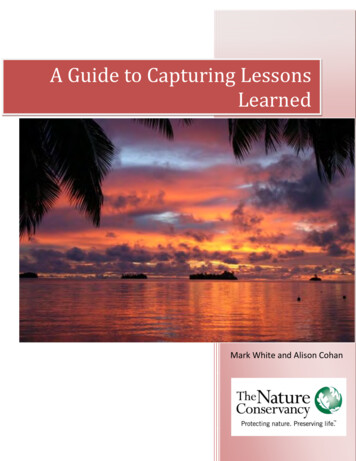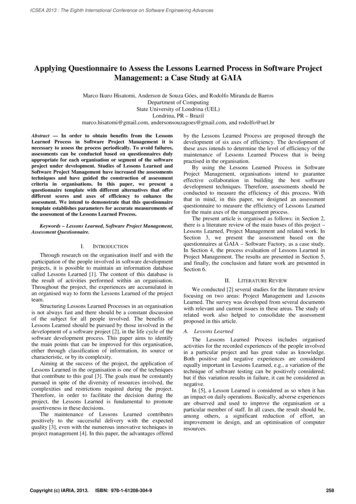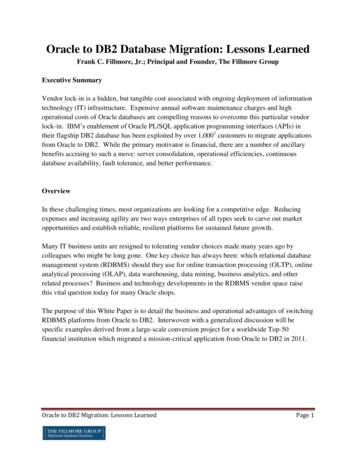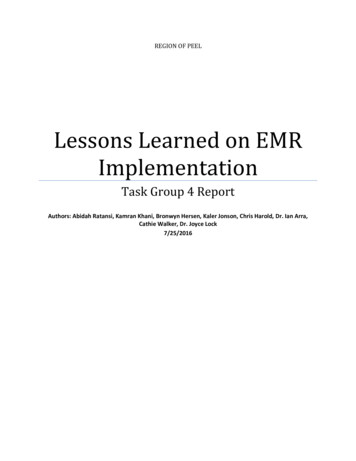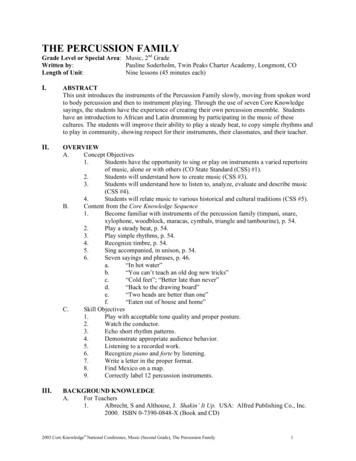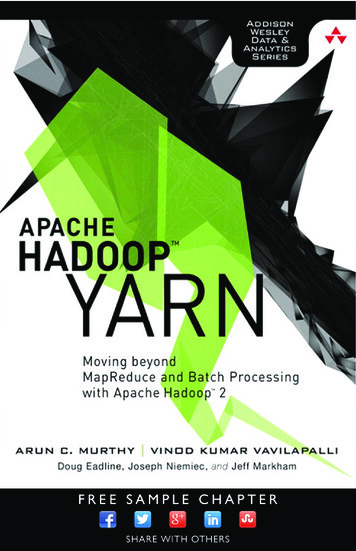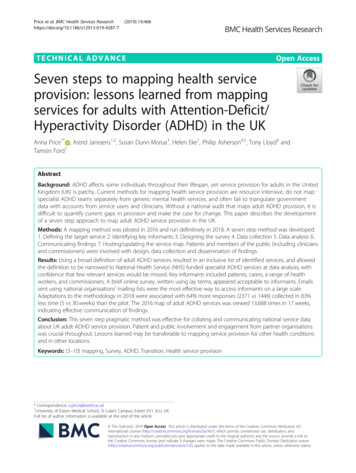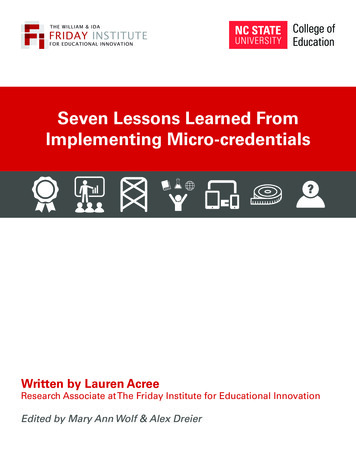
Transcription
Seven Lessons Learned FromImplementing Micro-credentialsWritten by Lauren AcreeResearch Associate at The Friday Institute for Educational InnovationEdited by Mary Ann Wolf & Alex Dreier
Seven Lessons Learned From Implementing Micro-credentialsIntroductionMore than a decade ago, Linda Darling-Hammond and her colleagues revealed that most professionallearning experiences in the U.S. are not adequately preparing teachers to make changes in theirclassrooms (Darling-Hammond, Wei, Andree, Richardson, & Orphanos, 2009). Still, the traditionalmethod of professional development has remained largely unchanged and often relies on short, onesize-fits-all workshops without ongoing and job-embedded aspects that support the impact in theclassroom.Micro-credentials provide an opportunity for educators to engage in rigorous, self-paced, jobembedded professional learning that is connected to the daily skills teachers need in theirclassrooms. This new wave in professional learning provides a way for teachers to earn recognitionfor the skills they acquire through formal and informal learning opportunities, to personalize theirprofessional learning that meets their needs, and to take what they learn and apply it to theirclassrooms.The Friday Institute for Educational Innovation has developed 15micro-credentials related to Learning Differences in partnershipwith the Oak Foundation and Digital Promise. These microcredentials comprise three stacks (Working Memory, ExecutiveFunction, and Motivation) of five micro-credentials each andrepresent a scaffolded pathway for teachers to integrate thecontent learned in the Learning Differences MOOC-Ed into theirclassrooms. In our first three months of implementing microcredentials, the Friday Institute has learned much about microcredentials; including the following:1.2.3.4.5.6.7.What is a MOOC-Ed?Massive Open Online Courses forEducators (MOOC-Eds) are freeprofessional learning designed foreducators. MOOC-Eds are selfdirected, peer-supported, projectbased, and allow for rich blendedlearning opportunities. They can beaccessed at any time, in any place, onany device.Learn more at mooc-ed.orgTeachers who earn micro-credentials want to earn moreMicro-credentials encourage teachers to apply skills to classroom practiceMicro-credentials scaffold teachers to engage at an increased level of rigorTeachers can demonstrate competency/mastery in a variety of waysInstructional design and online platform matterMicro-credentials should not have a one-size-fits-all approachMany questions still exist around micro-credentialsThis paper will share the design elements and lessons learned from integrating micro-credentials intoprofessional learning which can be supported through the Learning Differences MOOC-Ed. The datain this paper comes from the first micro-credentials in each stack.Page 1
Seven Lessons Learned From Implementing Micro-credentialsDesign ElementsWhile developing these micro-credentials, the Friday Institute considered several design elementsincluding:Self-Directed: Teachers can pursue micro-credentials at their own pace either on their own or as partof the MOOCs for educators.Job-Embedded: Each of the micro-credentials is directly tied to classroom practice and provides ascaffolded approach to building useful classroom skills.Competency-Based: Micro-credentials must measure an educator’s demonstrated ability to applyone specific skill in the classroom context.Research-Based: Micro-credentials are designed around skills that have been thoroughly researchedand have a demonstrated impact on classroom practice.This paper leverages data from our pilot in micro-credentials and details each of the lessons outlinedabove.Lesson #1: Teachers who earn micro-credentials want to earn more97%After completing the Learning Differences micro-credentials,educators had an opportunity to participate in a survey to providethe Friday Institute with formative feedback. In these surveys, 97% of respondentswanted to pursueof respondents indicated that they wanted to pursue another micro-credentialanother microin the future. One teacher articulated in the survey that the micro-credentialscredential“made me focus on what I am already doing, and where I need more support.”Another shared that the micro-credentials “changed my way of thinking. I planto make a lot of changes on how I teach my PK-8 students this coming school year.” The commentsand statistics above provide evidence that teachers are finding value in engaging with the microcredentials.Lesson #2: Micro-credentials encourage teachers to apply skills toclassroom practiceOften in professional development opportunities, teachers are asked to makeapplications to case studies or hypothetical students. The purpose of these activitiesis to provide scaffolding so that teachers will then be able to go back to their classrooms and makePage 2
Seven Lessons Learned From Implementing Micro-credentialsthe applications to their own students. However, whether or not those connections are made isoften unknown; and data suggests teachers do not often change their practice after professionallearning experiences (Yoon, et. al. 2007). Micro-credentials enable professional learning providers tosee the connections teachers made to their own practice by asking teachers to submit artifacts thatdemonstrate how they have integrated the practice into their classrooms.In the Learning Differences MOOC-Ed and micro-credentials, one participant provided the followingreflection on a case-study about a student with working memory deficits:“Watching Molly’s Story made me think of several students I have worked with who havedemonstrated some of her traits. They have problems with remembering instructions, and doingmulti-step tasks. In math, long division algorithms are especially challenging. The video gave mea new perspective on why they struggle, and I am inspired to handle their instruction differentlywith more understanding.”In this reflection, the participant shared that she intends to return to her classroom and makesubstantive changes to how she teaches and supports students struggling with long division. In hermicro-credential submission, we see more about how she actually enacted this plan:Figure 1: Student work using the “Does McDonald’s Serve CheeseBurgers” signal.“I have already begun to use the technique ofpresenting directions visually as well as verbally,and purposely giving directions slowly and onestep at a time [to support students’ workingmemory]. These include using cues to retrieveinformation, such as using an acronym DoesMcDonald’s Serve CheeseBurgers as a signalfor the steps in long division (Divide MultiplySubtract Check Bring down), providing lotsof practice in different ways (written, games,projects, movement), and working on practicetests to help with retrieval of information.”Other participants shared similar experiences in a survey, explaining, “I adjusted my lesson plansa little so they included strategies to assist students in developing working memory. I had alreadyused some strategies but not consistently. This exercise helped me by realizing I needed to writestrategies into the plan in order to become consistent.”These artifacts provide professional development providers with rich evidence of what teachers arePage 3
Seven Lessons Learned From Implementing Micro-credentialsdoing in their classrooms. The strategy shared by the teacher above is not revolutionary, but theconnection between the strategy and working memory reflects a shift in mindset. This indicates thatthe Learning Differences MOOC-Ed changed her practice and approach to teaching.Lesson #3: Micro-credentials scaffold teachers to engage at anincreased level of rigorProfessional development often asks teachers to make applications, but seldom asksteachers to think metacognitively or evaluatively. Carefully crafted micro-credentials cansupport educators as they engage in more rigorous learning.The Learning Differences MOOC-Ed provided teachers with many resources to enrich theirunderstanding of the various constructs presented (working memory, executive function, andmotivation). Throughout the forums, participants share their reflections about the resources. Themicro-credentials bring more structure to these reflections and ask educators to not only share whatthey learned from the resources provided, but also what made them effective. This push towardmetacognition and evaluation facilitates more rigorous learning.For example, one teacher provided the following reflection for her Demonstrate Understanding microcredential in the working memory stack:Initial Demonstrate Understanding Reflection“The video “Molly’s Story” provides a very good understanding of working memory. In this video, Mollytalks about her working memory deficit in regards to not being able to recall information because she isso focused on other details of a conversation. The example that she cites is meeting a person and havinga conversation with them. She stated that after a minute of talking with someone that she is unable torecall their name because she is focusing on the conversation that they are sharing. The working memoryis not processing because she loses her concentration and focus on other factors of the conversation.Another good example that Molly cites is being given a set of directions to complete a task. She explainsthat she may be able to recall the first and last step of the directions but is unable to remember the stepsin between. These are good examples of working memory deficit. It definitely shows a lack of ability tocategorize and recall order.”Figure 2The submission evaluation team found that this reflection did not provide information regarding howthis video resource supported this educator’s understanding of working memory. In response, theteacher re-submitted the following reflection.Page 4
Seven Lessons Learned From Implementing Micro-credentialsRevised Demonstrate Understanding Reflection“The video “Molly’s Story” provides a very good understanding of working memory. In this video, Mollytalks about her working memory deficit in regards to not being able to recall information because she isso focused on other details of a conversation. The example that she cites is meeting a person and havinga conversation with them. She stated that after a minute of talking with someone that she is unable torecall their name because she is focusing on the conversation that they are sharing. The working memoryis not processing because she loses her concentration and focus on other factors of the conversation.It is as if she is so focused on the first thing that she hears in the conversation that she is unable toprocess consequent information. Then, as the information begins to overwhelm her, she focuses on thelast thing that she hears. To a person with good working memory skills, they are able to take in all of theinformation and sort it and relate it to the topic. Another good example that Molly cites is being givena set of directions to complete a task. She explains that she may be able to recall the first and last stepof the directions but is unable to remember the steps in between. These are good examples of workingmemory deficit. It definitely shows a lack of ability to categorize and recall order. I suppose I have a goodworking memory because I am very organized and I like order. My thought process works best when Iam able to itemize things and generate lists. In addition, I enjoy accomplishing tasks on my list, whichpushes me to complete the task at hand. I like to think of my working memory processing as a complexfiling system. I take the information that I am given and sort it into categories that correspond in somemanner. This process allows me to retrieve my thoughts much easier because their is a correlationbetween the information that I have stored.”Figure 3The revised reflection unequivocally provides more details, provides evidence of metacognition, andmakes concrete applications to her own life and practice.Users (like this one) are not being awarded for merely summarizing the content provided in thecourse. They are being encouraged to think about it critically; uncovering exactly what made it helpfuland making applications to their practice. As one participant shared in the post- completion survey,micro-credentials “provided [her] with knowledge and tools to evaluate [her] current practice and todetermine areas where [she] can implement additional strategies to support students in this area.”While many teachers and learners do this on their own, the micro-credentials provide an opportunityfor facilitated, structured reflections wherein teachers can get meaningful feedback.Lesson #4: Teachers can demonstrate competency/mastery in avariety of waysWhen the Friday Institute designed the Learning Differences micro-credentials,the team hoped that educators would take this opportunity to make the learningexperience work for them. Educators’ implementations have surpassed expectations. Educators havePage 5
Seven Lessons Learned From Implementing Micro-credentialssubmitted a wide variety of artifacts to demonstrate their knowledge and skill. They have createdpoems, taken pictures, written moving and personal reflections, and video-taped their teaching.Through micro-credentials, teachers are taking control of their professional learning and personalizingtheir submissions to meet their context and their needs.Each of the artifacts below were completed for the Learning Differences micro-credentials andhighlight the variety of ways teachers are sharing their learning:Learner MotivationThis teacher helped build student agency by providing topic and presentation choice. These two boys,from a rural, hunting community, chose to complete their Spanish vocabulary and sentence structurelesson using PowerPoint.Figure 4: Artifact submitted by a teacher showing how two students used PowerPoint for a class assignment.Partnering with Students in Working Memory“The artifact is an example of what the student worked on to help memorize key terms and conceptsfor an upcoming assessment on the causes of the American Revolution. Since the student struggleswith her working memory, she tends to retaininformation better with various visual images, thisstudy strategy helped the student to use a “tool”that she knew would work best. During our studysession, if she was struggling I would encourageher to visually think about the picture that shedrew. This typically prompted the terms’ definitionand together, we could discuss and talk about theeffects the law had on the colonists.”Figure 5: Artifact submitted by a teacher showing how one studentused visuals to help with her working memory.Page 6
Seven Lessons Learned From Implementing Micro-credentialsDemonstrate Understanding in Executive FunctionOne teacher sent in a photo as part of her reflection demonstrating her understanding of executivefunction.Figure 6: One teacher compared executive function skills to a chef managing a busy kitchen.“An area where I see many students struggle is setting themselves up for class--having the foresightto gather the tools needed to complete a task efficiently. At a restaurant this concept is called “Miseen-place,” or everything in its right place. To make a recipe, the chef will get out all of the dishes,ingredients, etc that he will need. For students, they might realize they are going to need a pen,scratch paper, and eventually a dictionary, so they can get all of that out at the same time to avoiddisruptions or distractions later. A great story on this is from NPR: f”Working Memory“I have written the following poem in response to this assignment. It is based on recent experience Ihad supervising a student, who I believe has working memory difficulties, in a state exam. It’s called‘Testing Time’ and I try to capture the tasks that were very challenging for him, how easy it would beto give up and the importance of continuing to encourage and be present with the student in such asituation. There are also references to the accommodations which help a lot also.”Testing TimeIt is testing time.I feel so anxious.What if I forget and.All falls through thesieve?Short questions, tick boxI’m flying these.But steps in MathsAbstractions andTime tight composing!The tapes are sealed nowWith my scriptsIn red envelopes.And we must hopeMy supervisorNervous like I am.For failure is aFrightening thing.Thoughts melt, words failToo hard! I buckle.She holds things fastEncouraging:‘I think you can’That those who sift myworkWill hold a human handBeneath the sieveAnd hear my clear strongvoiceAmid the falling words.And knowThat testing timeMeans more,Than we might yetunderstand.Figure 7: Poem entitled Testing Time submitted by an anonymous MOOC-Ed participant.Page 7
Seven Lessons Learned From Implementing Micro-credentialsLesson #5: Instructional design and online platform matterWe found that it was important to consider how users would engage with the microcredentials throughout the development process. During development, the team at theFriday Institute realized that micro-credentials are a very different way for educatorsto learn and engage online. The team developed a platform to facilitate this new mode of contentdelivery and quickly learned its importance.The structure of the online platform must make it both clear and easy for educators to: know what the micro-credential seeks to measure, understand what they must do in order to earn the micro-credential, submit all of the necessary materials in order to earn the micro-credential, and get feedback and know why they did or did not earn a micro-credential.During our soft launch in summer 2015, our platform clearly outlined the competency and providedclear guidance to educators about what they must do to earn the micro-credential. However, it failedto make it easy to submit all of the necessary materials and to understand why the educator receivedor did not receive the micro-credential. This fall, however, the Friday Institute improved its platformon the Professional Learning and Collaboration Environment (PLACE) website, where courses wereoffered, and found that educators felt much better supported.In the initial implementation in the summer of2015, 55% of educators started but did not finishany of the micro-credentials. After applying courseimprovements for the fall 2015 implementation,that number decreased to 27%. This indicates thatthe ease of submitting and understanding what isnecessary has improved.After course improvements were applied,the percentage of participants who startedbut did not finish the micro-credentialsdecreased from55% to 27%Additionally, this summer, no teachers re-submitted artifacts after receiving feedback. Afterimplementing course improvements, however, 12 educators out of 23 have resubmitted afterreceiving feedback from their submissions. This demonstrates the importance of eliminating thebarriers to completion by being transparent with participants about expectations and results.Page 8
Seven Lessons Learned From Implementing Micro-credentialsLesson #6: Micro-credentials should not have a one-size-fits-allapproachAs with any instructional design, there is not a silver bullet approach to making greatmicro-credentials. The framework developed for the Learning Differences MOOC-Edhas been well received and effective. However, as we begin to develop more micro-credentials, thecontent must be an important factor in the design and structure of the micro-credentials.For example, the Friday Institute team has started taking the experience from the LearningDifferences micro-credentials and applying it to other contexts, specifically our Fractions FoundationsMOOC-Ed. While developing these micro-credentials we realized that taking the framework from thelearning differences model and dropping it untouched into the Fractions course would not work. Justas with instructional course design, the content and goals of a learning experience must inform thedevelopment of the micro-credentials.Lesson #7: Many questions still exist around micro-credentialsWhile the Friday Institute team has learned a lot, many more questions than answershave emerged through this work. As we have developed upcoming courses, we haveconsidered some of the following questions: What’s the right grain size for a micro-credential? How do we scale micro-credentials? What are the necessary incentives? Should micro-credentials be connected to systemic processes like teacher licensure andrelicensure? As more organizations build micro-credentials, how can we continue to ensure high-quality micro-credentials?As micro-credentials become more prominent parts of professional development for educators,these and other questions will become increasingly important. The Friday Institute’s micro-credentialteam is partnering with Digital Promise to continue these conversations and begin tackling the hardquestions. Additionally, it is critical for leading professional development providers to come togetherand consider these questions, share experiences, and continue improving professional developmentso that it works better for educators across the globe.Page 9
Seven Lessons Learned From Implementing Micro-credentialsNext Steps and RecommendationsThe Friday Institute is excited about the potential of micro-credentials based upon this firstimplementation around the Learning Differences MOOC-Ed. Currently, discussions about districtpilots, state-level considerations for licensure and relicensure, and possibilities for micro-credentialsas part of the undergraduate or graduate level degrees are underway. Superintendents, principals,and teachers alike seem curious about and interested in the possibilities of using micro-credentials asa catalyst for changing the way we think about and recognize professional learning.The Friday Institute will be doing the following, at a minimum, in the next 12-18 months: Continue to implement and validate the Learning Differences micro-credentialsDevelop and implement micro-credentials for teaching fractions and statisticsConduct research around how earning micro-credentials impacts teachers’ practiceExplore micro-credentials for district and school leaders, with a focus on digital learning withindustry partners Explore necessary levers and existing barriers for scaling micro-credentials Work with partners, such as Digital Promise, to build a model for peer-to-peer assessment ofsubmissionsThe Friday Institute encourages interested partners and educators to reach out, pilot, integrate intoprofessional learning and licensure, and provide feedback to continue to build the knowledge baseand improve the implementation of micro-credentials.Page 10
Seven Lessons Learned From Implementing Micro-credentialsAbout the AuthorLauren Acree is a Research Associate at the Friday Institute for Educational Innovation where sheserves as the Policy and Personalized Learning Lead. Currently, Lauren leads the Learning DifferencesMOOC-Ed and micro-credentialing teams. She has developed content for the Leadership in BlendedLearning program, contributed to the North Carolina Digital Learning Plan, and the State Leaders inDigital Learning Course. Lauren has also worked closely with the Alliance for Excellent Educationand the U.S. Department of Education to plan and facilitate sessions for the Future Ready initiativeto district teams across the nation. Prior to working at the Friday Institute, she worked as a specialeducation teacher in Tulsa, Oklahoma. Lauren earned her Bachelor’s degree at the University ofRichmond in Richmond, Virginia and her Master in Public Policy from Duke University. You can contacther at lkmilam@ncsu.edu or 919-513-8577.About the Friday InstituteThe mission of the Friday Institute is to advance education through innovation in teaching, learning,and leadership. Bringing together educational professionals, researchers, policy-makers, andother community members, the Friday Institute is a center for fostering collaborations to improveeducation. We conduct research, develop educational resources, provide professional developmentprograms for educators, advocate to improve teaching and learning, and help inform policy-making.Learn more at fi.ncsu.edu.Recommended Resources from the Friday Institute Micro-credentials at the Friday Institute: go.ncsu.edu/microcredentialsPersonalizing Professional Learning with Digital Badges: go.ncsu.edu/badgesNorth Carolina Digital Learning Plan: ncdlplan.fi.ncsu.eduState Digital Learning Exemplars: go.ncsu.edu/dlexemplarsSuggested Citation:Acree, L. (2016). Seven Lessons Learned From Implementing Micro-credentials. Raleigh, NC. FridayInstitute for Educational Innovation at the NC State University College of Education.Creative Commons Licensing: This work is licensed under the Creative Commons Attribution 3.0 Unported License. To view a copy ofthis license, visit http://creativecommons.org/licenses/by/3.0/ or send a letter to Creative Commons, 171 Second Street, Suite 300, SanFrancisco, California, 94105, USA.Page 11
2. Micro-credentials encourage teachers to apply skills to classroom practice 3. Micro-credentials scaffold teachers to engage at an increased level of rigor 4. Teachers can demonstrate competency/mastery in a variety of ways 5. Instructional design and online platform matter 6. Micro-credentials should not have a one-size-fits-all approach 7.


